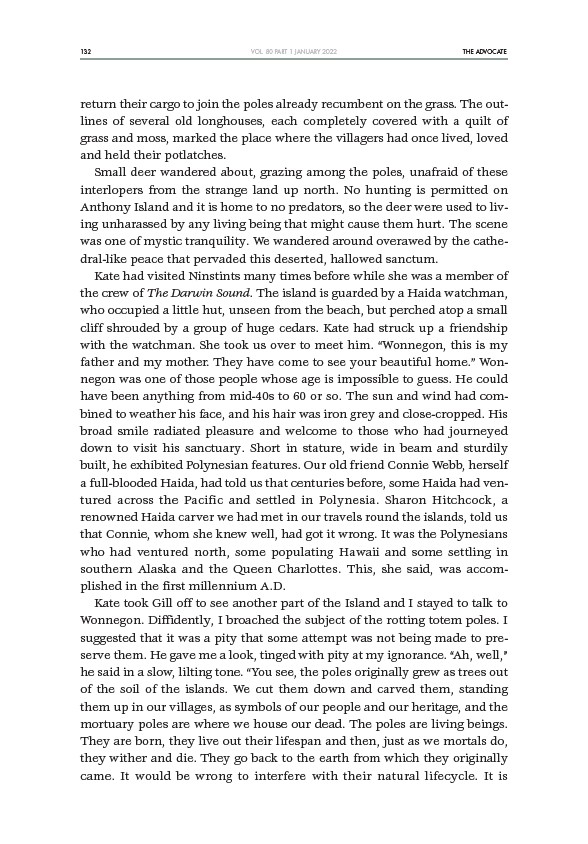
132 THE ADVOCATE
VOL. 80 PART 1 JANUARY 2022
return their cargo to join the poles already recumbent on the grass. The outlines
of several old longhouses, each completely covered with a quilt of
grass and moss, marked the place where the villagers had once lived, loved
and held their potlatches.
Small deer wandered about, grazing among the poles, unafraid of these
interlopers from the strange land up north. No hunting is permitted on
Anthony Island and it is home to no predators, so the deer were used to living
unharassed by any living being that might cause them hurt. The scene
was one of mystic tranquility. We wandered around overawed by the cathedral
like peace that pervaded this deserted, hallowed sanctum.
Kate had visited Ninstints many times before while she was a member of
the crew of The Darwin Sound. The island is guarded by a Haida watchman,
who occupied a little hut, unseen from the beach, but perched atop a small
cliff shrouded by a group of huge cedars. Kate had struck up a friendship
with the watchman. She took us over to meet him. “Wonnegon, this is my
father and my mother. They have come to see your beautiful home.” Wonnegon
was one of those people whose age is impossible to guess. He could
have been anything from mid-40s to 60 or so. The sun and wind had combined
to weather his face, and his hair was iron grey and close-cropped. His
broad smile radiated pleasure and welcome to those who had journeyed
down to visit his sanctuary. Short in stature, wide in beam and sturdily
built, he exhibited Polynesian features. Our old friend Connie Webb, herself
a full-blooded Haida, had told us that centuries before, some Haida had ventured
across the Pacific and settled in Polynesia. Sharon Hitchcock, a
renowned Haida carver we had met in our travels round the islands, told us
that Connie, whom she knew well, had got it wrong. It was the Polynesians
who had ventured north, some populating Hawaii and some settling in
southern Alaska and the Queen Charlottes. This, she said, was accomplished
in the first millennium A.D.
Kate took Gill off to see another part of the Island and I stayed to talk to
Wonnegon. Diffidently, I broached the subject of the rotting totem poles. I
suggested that it was a pity that some attempt was not being made to preserve
them. He gave me a look, tinged with pity at my ignorance. “Ah, well,”
he said in a slow, lilting tone. “You see, the poles originally grew as trees out
of the soil of the islands. We cut them down and carved them, standing
them up in our villages, as symbols of our people and our heritage, and the
mortuary poles are where we house our dead. The poles are living beings.
They are born, they live out their lifespan and then, just as we mortals do,
they wither and die. They go back to the earth from which they originally
came. It would be wrong to interfere with their natural lifecycle. It is